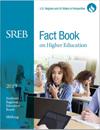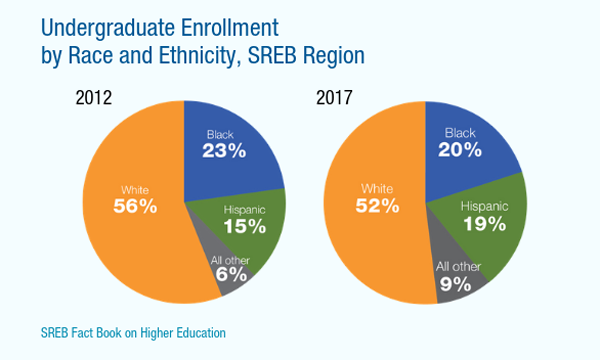Postsecondary Trends Threaten Workforce Needs
Fact Book Documents Challenges to Education Attainment Goals
Postsecondary attainment continues a slow climb in the South,
according to the 2019 Fact Book on Higher
Education.
Population and college enrollment trends are beginning to slow at
a time when advancing technology and artificial intelligence are
shifting the workplace to demand higher-level skills. And
affordability remains a stubborn challenge to students and
families and to states trying raise state education attainment
levels to grow their economies.
“Within the next 10 years, SREB states face serious challenges in
meeting workforce needs,” said SREB President Stephen L. Pruitt.
“K-12 and postsecondary education will need to combine efforts to
prepare more people for middle-skills jobs as well as high-skill
ones.”
SREB.org/FactBook >
Enrollment: College enrollment declined 3%
in the SREB region and 5% nationally from 2012 to 2017.
Enrollment dropped in 14 of the 16 SREB states.
Enrollment at four-year institutions was almost flat nationwide
and grew only about 2% in the SREB region. Two-year college
enrollment dropped 11% nationwide and 10% in the SREB region
“The drop at two-year colleges is troubling, because they enroll
more of the non-traditional-age students returning to complete
credentials or to learn new skills as lower-skill jobs
disappear,” said Susan Campbell-Lounsbury, SREB director of
education data services and author of the Fact
Book.
Attainment: Among adults 25 to 64 years
old, 39% held an associate degree or higher in 2017, up from 36%
in 2012 but lower than the 2017 national average of 42%.
The population pipeline: K-12 enrollment in the SREB region
is still growing faster than the national average, and high
school graduation rates are up. But by the early 2030s, the South
will experience a slowdown in school and college enrollments.
Affordability: In-state costs at public four-year institutions increased 4% from 2016-17 to 2017-18 in the SREB region and 2% nationally. Pell Grant dollars to students dropped nearly 6% in the region, and the number of Pell Grant recipients dropped 18%. The South led other regions in state scholarships and grants, at 43% of the nation’s total.
Dual Enrollment
Dual enrollment is growing in the Southern region. From 2014-15
to 2016-17, the percentage of college graduates who had taken
college courses while in high school increased in 10 of the 12
SREB states that report this information.
About the Fact Book
 Since 1956, the SREB Fact Book
on Higher Education has chronicled progress in the South as
states raised their education attainment levels year after year.
Accurate data and comparisons allow state and institution leaders
to track progress, understand trends, and guide their efforts to
meet goals for postsecondary attainment.
Since 1956, the SREB Fact Book
on Higher Education has chronicled progress in the South as
states raised their education attainment levels year after year.
Accurate data and comparisons allow state and institution leaders
to track progress, understand trends, and guide their efforts to
meet goals for postsecondary attainment.
For all 50 states and the District of Columbia, the Fact Book covers:
- Population and economic trends that drive education
- Enrollment and graduation by type of college and degree
- Tuition and fees
- State and federal financial aid
- Faculty salaries
- College revenues and expenditures
- State and federal funding for higher education
Find Fact Book essays, spreadsheets and charts, plus individual Featured Facts booklets for the 16 SREB states, at SREB.org/FactBook. Fact Book tables are updated continually online.
Request print copies >
Media Contact: Beth Day, (404) 879-5544
A nonprofit, nonpartisan interstate compact, SREB was created in 1948 by Southern governors and legislators who recognized the link between education and economic vitality. SREB states are Alabama, Arkansas, Delaware, Florida, Georgia, Kentucky, Louisiana, Maryland, Mississippi, North Carolina, Oklahoma, South Carolina, Tennessee, Texas, Virginia and West Virginia.


